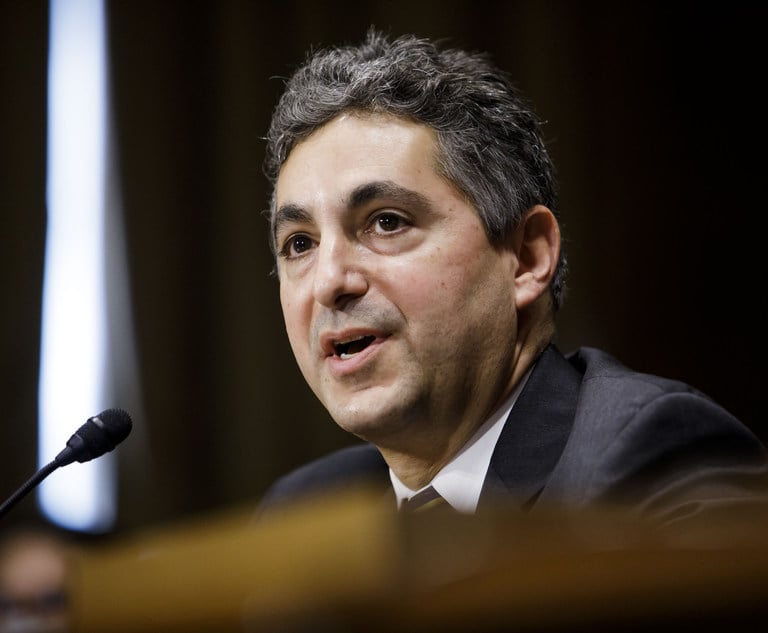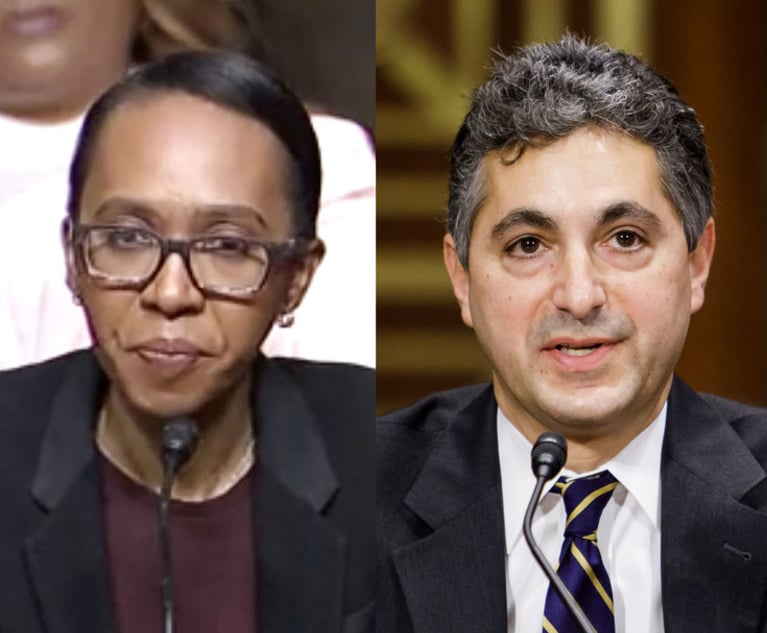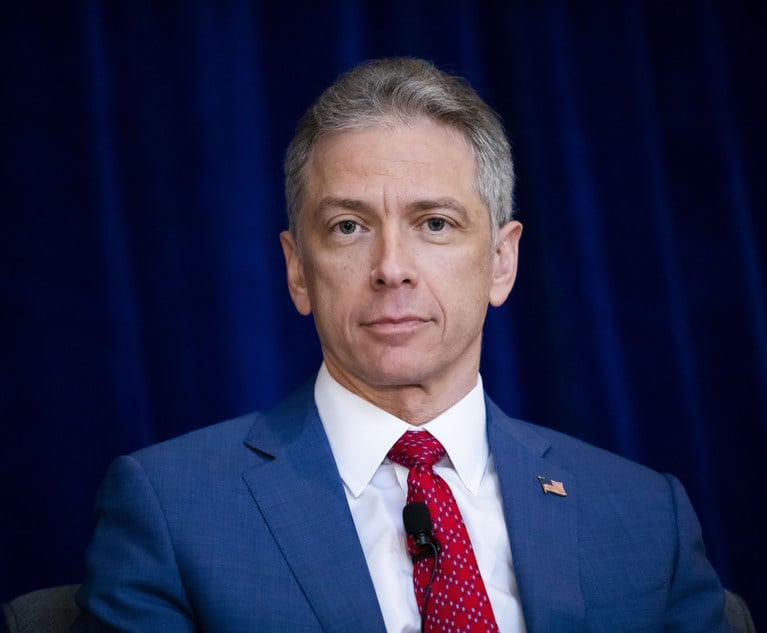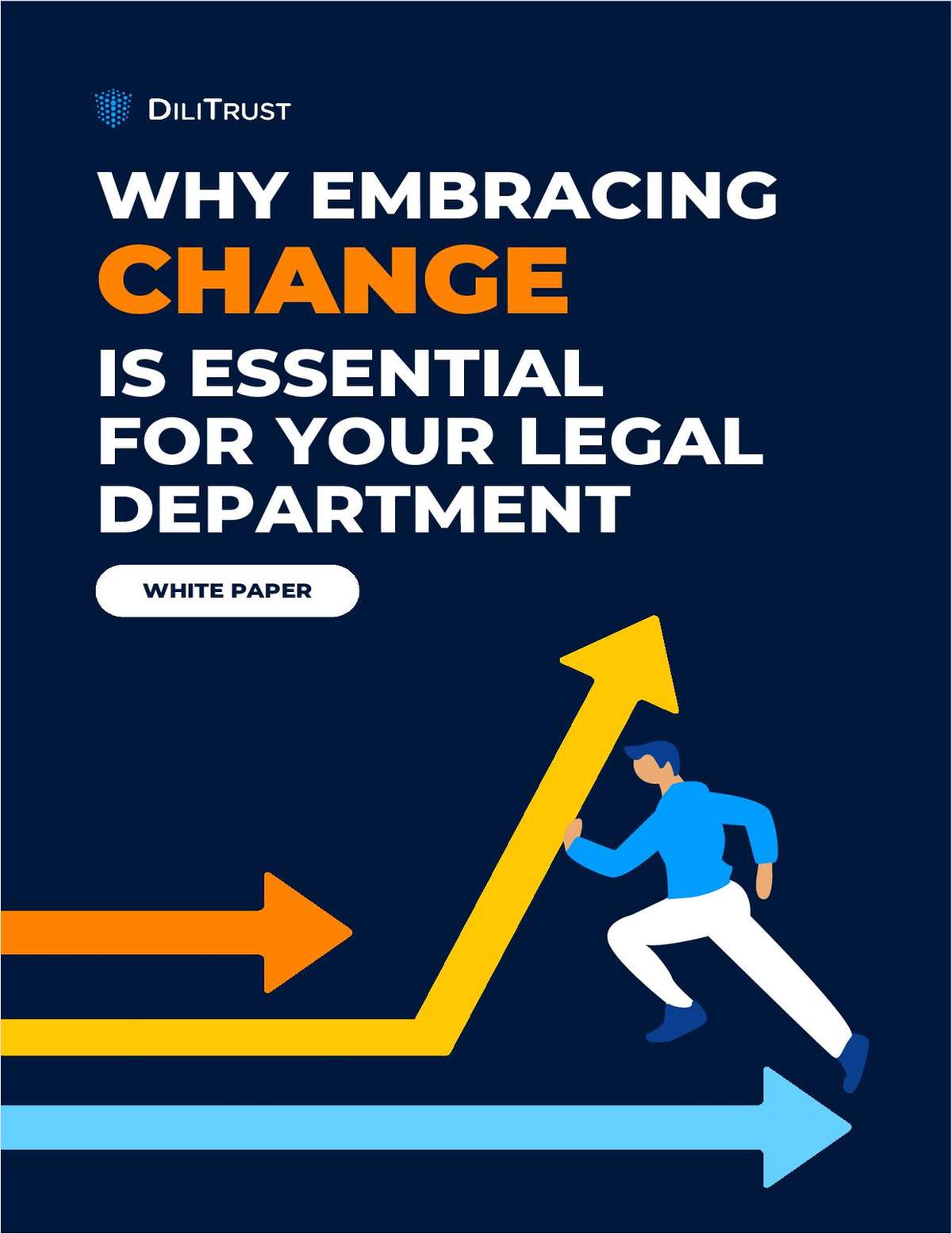Skilled in the Art: The USPTO's Plan for Highlighting COVID Inventions + SCOTUS Eyes AIA Retroactivity + Killer Robots Aren't Coming for Judge Tse
McAndrews, Held & Malloy partner Sharon Hwang outlines Patents 4 Partnership, one of many new COVID-19 related initiatives the USPTO has been rolling out.
June 12, 2020 at 07:17 PM
10 minute read
Welcome to Skilled in the Art. I'm Law.com IP reporter Scott Graham. Here's what's cracking today:
• McAndrews, Held & Malloy partner Sharon Hwang outlines Patents 4 Partnership, one of many new COVID-19 related initiatives the USPTO has been rolling out.
• The U.S. Supreme Court has now twice relisted two cert petitions challenging the retroactive application of the America Invents Act.
• Amazon says Williams Sonoma's killer robot concerns are overblown.
As always, you can email me your feedback and follow me on Twitter.
 McAndrews partner Sharon Hwang (Photo: Courtesy photo.)
McAndrews partner Sharon Hwang (Photo: Courtesy photo.)How USPTO Aims to Match COVID-19 Inventors With Commercializers
The U.S. Patent and Trademark Office has been launching new initiatives at breakneck speed during the COVID-19 pandemic. One of the more intriguing is Patents 4 Partnership, an online meeting place for inventors and commercializers of potentially COVID-fighting technologies. I spoke with McAndrews, Held & Malloy partner Sharon Hwang about the program earlier this week. Hwang's litigation credits include a $254 million judgment on behalf of medical device company Stryker.
Q. Can you describe the Patents for Partnership program?
A. The program launched in early May. It's basically a repository of searchable patents and patent applications that relate to the COVID-19 pandemic and are available for licensing. The point of the program is really to provide a meeting space to connect up patent owners that want to license their rights to individuals or businesses or start-ups or manufacturers who have the ability to actually commercialize the inventions.
After they meet, they're sort of on their own. Whatever license arrangement they come up with is a private license arrangement. So it's not something the Patent Office is monitoring per se. And there are advantages to that.
Q. For example?
A. Well, you've seen some of the news articles, discussions about the Open-COVID Pledge. There are different organizations—mostly tech companies, not so much the medical device space—that are taking a pledge that basically says, "All right, you are free to use our IP to fight this pandemic."
And that's all great. It's just that any time there are collaborations and people are using other people's IP, inevitably there's going to be problems that come up along the way or perhaps later on when improvements are made, and it's like well, who owns what? Those are things that usually, when parties get together, they have an agreement that sets forth all of that.
Q. Who qualifies for the program?
A. I'm assuming the Patent Office has pulled together patents from a database. It seems to be mostly university-owned or federal agency owned patents. But it's not intended to exclude anybody. So if you're a solo inventor or a small business or even a large company and you want to place your COVID-related patents and patent applications in the database, you can. There's a means to manually submit your information.
Q. You mentioned that it's issued patents and patent applications. Is that important?
A. It is important. It could take awhile for such an invention to go through the Patent Office, even though right now they're prioritizing certain COVID-related inventions.
Having patent applications out there is great. It's unusual. I'm not aware of other marketplaces that have published patent applications. Parties that want to commercialize may want to be involved with the prosecution of the patent application, if it can come to an agreement with the patent owner. That can be very valuable to both the patent owner and the licensee.
It really does seem like a helpful program for folks like universities or other entities that maybe don't have the resources [to locate a partner]. Sometimes you have no idea what other entities might be out there that are looking to commercialize a particular product.
Q. Aside from this program, are you seeing collaborations occurring in the medical device, medical equipment space? A. Yeah, absolutely. There's one that's top-of-mind for me because my cousin is involved. It's when the University of South Florida, the medical school, put out their 3D-printer nasal swab design for others to use. It was for hospitals and other institutions to 3D-print them on site and use them as they needed.
It was patent-protected or patent-application protected, but they provided a limited license until I think it was April 2021 for folks to be able to use their design for non-commercial purposes, so that they could help fight this pandemic. Q. Who are some others?
A. I'm gonna have to give a shout-out to my alma mater, the University of Illinois, the Grainger College of Engineering. The university has recently opened the first engineering-focused medical school in the world. So a lot of the engineering professors are also teaching at the medical school, and vice versa.
They had a team of 40 engineers and doctors that got together in March. They decided they were going to design a device that would help people breathe, that would help with the lack of ventilators. Within one week they had a working prototype. It's called the Illinois RapidVent. It's been licensed by more than 60 organizations. It was made available for a free license.
Our client Stryker came out with low-cost, emergency-relief beds for pop-up sites. I know they were looking to manufacture 10,000 beds a week. They've also come up an emergency-relief patient cover. It's kind of cool looking. It's like a bubble that's only over the head. That's something where Stryker worked with its front-line workers and health care providers to figure out what was needed to help protect them.
|
SPONSORED BY ALM PARTNERS
Microsoft Excel – Quick Reference Guide
This Microsoft Excel Reference provides shortcuts, tips, and tricks for the spreadsheet software. Use this reference to brush up on the basics and to find alternative methods to your favorite commands. This printable quick reference is yours to use, distribute, and share at your organization! READ MORE
 Jones Day partner Greg Castanias (Photo: Diego Radzinschi/ALM)
Jones Day partner Greg Castanias (Photo: Diego Radzinschi/ALM)
High Court (Still) Eyeing AIA Retroactivity
The Supreme Court is taking a long look at new constitutional challenges to the America Invents Act and the operations of the Patent Trial and Appeal Board.
The court has now twice re-listed cert petitions in Celgene v. Peter and Collabo Innovations v. Sony.Petitioners in those cases argue that applying the AIA retroactively amounts to a taking of patent owners' property rights without compensation.
"This case presents another important question regarding the legitimate operation of this bureaucratic juggernaut, a question having broad implications for protection of property rights," a Jones Day team led by partner Greg Castanias wrote in Celgene's cert petition.
The court has already hinted that it might open to Celgene's and Collabo's arguments. In Oil States Energy Services v. Greene's Energy, the 2018 decision rejecting a Seventh Amendment challenge to the AIA, Justice Clarence Thomas emphasized the narrowness of the holding.
"We address only the precise constitutional challenges that Oil States raised here," Thomas wrote in a 7-2 decision. "Oil States does not challenge the retroactive application of inter partes review, even though that procedure was not in place when its patent issued. Nor has Oil States raised a due process challenge. Finally, our decision should not be misconstrued as suggesting that patents are not property for purposes of the Due Process Clause or the Takings Clause."
Bristol-Myers Squibb subsidiary Celgene has taken that argument and run with it, arguing that when it obtained patents in the late 1990s and early 2000s on methods for safely administering thalidomide, it assumed those patents were on solid ground. "The retroactive application of the America Invents Act (AIA), which unmistakably made revolutionary changes to the Patent Act, upends these reliance interests," the Jones Day lawyers argue. Partner Jennifer Swize and associate Robert Stander are also on the petition.
Collabo's patent on an improved design for the packaging of an imaging sensor was issued in 1999. The cancellation of a patent claim is a complete removal of the owner's personal property, and should be regarded as a complete, "physical" taking under the Takings Clause," argue Collabo's lawyers at Bragalone Conroy, led by partner Patrick Conroy. Alternatively, the retroactive application of the AIA should be considered a regulatory taking under Penn Central Transportation v. City of New York, they argue.
The Justice Department argues, and the Federal Circuit agreed, that inter partes review is similar enough to its pre-AIA predecessors—inter partes reexamination and ex parte reexamination—that reliance interests aren't implicated.
The DOJ team includes attorneys Scott McIntosh and Dennis Fan. They also stress holdings from previous Supreme Court decisions that IPRs don't rescind patents, but instead represent a "second look" at patents that were never validly issued.
Celgene dates to 2015, when a vehicle operated by hedge fund manager Kyle Bass began shorting pharmaceutical stocks and then filing IPR petitions challenging their patents, which tended to cause temporary drops in the pharma companies' stock prices. The Coalition for Affordable Drugs followed through with many of those IPRs and invalidated a handful of patents, including the two at issue in Monday's case. But the coalition did not defend its win on appeal, instead leaving that to the PTO and DOJ, which are authorized by the AIA to intervene in IPR proceedings and their appeals.
Sony is represented by Andrew Baluch of Smith Baluch and by Kirkland & Ellis, and is supported by DOJ. Among other things, Sony argues that Collabo waived its constitutional arguments by failing to raise them before the PTAB.
 |
|Quick hits
➤ I wrote last week that Williams Sonoma and Amazon are setting up a popcorn hearing on copyright liability for a software program that can allegedly choose images for display on a website. Williams Sonoma has compared Amazon's AI software to a Frankenstein's monster, and warned that too lax a rule could ultimately lead to dystopian mass murder with no one held responsible. Amazon and Durie Tangri partner Mark Lemley fired back Wednesday, saying that Williams Sonoma's "colorful hypotheticals" can't transform an ordinary internet-intermediary-
➤ U.S. District Judge Alan Albright has made clear that he's no fan of Section 101 motions, especially in the early stages of litigation. But could it be that the judge will look more kindly on traditional theories of invalidity? Following a June 5 Markman hearing, the Western District of Texas judge issued an order saying he would invalidate claims asserted by Flash-Control LLC against Intel based on written description. Intel had argued there was "a complete mismatch" between asserted claims of the 8,531,880 and 8,817,537 continuation patents and the claim specification drafted five years earlier. A Wilmer Cutler Pickering Hale and Dorr team led by partner Sonal Mehta represented Intel along with Austin counsel Kelly Hart & Hallman.
➤ New York's Warshaw Burstein has launched a copyright and trademark law practice group with the addition of partner William Samuels. Samuels joins the firm from Scarinci Hollenbeck. "We are fortunate to be in a position to continue to build our firm, even amid challenging circumstances," Warshaw Burstein managing partner Frederick Cummings Jr. said in a written statement. "I welcome Bill to Warshaw Burstein."
That's all from Skilled in the Art this week. I'll see you all again next Friday.
This content has been archived. It is available through our partners, LexisNexis® and Bloomberg Law.
To view this content, please continue to their sites.
Not a Lexis Subscriber?
Subscribe Now
Not a Bloomberg Law Subscriber?
Subscribe Now
NOT FOR REPRINT
© 2024 ALM Global, LLC, All Rights Reserved. Request academic re-use from www.copyright.com. All other uses, submit a request to [email protected]. For more information visit Asset & Logo Licensing.
You Might Like
View All
Skilled in the Art With Scott Graham: I'm So Glad We Had This Time Together

Design Patent Appeal Splinters Federal Circuit Panel + Susman Scores $163M Jury Verdict + Finnegan Protects Under Armour's House
Law Firms Mentioned
Trending Stories
- 1The Key Moves in the Reshuffling German Legal Market as 2025 Dawns
- 2Social Media Celebrities Clash in $100M Lawsuit
- 3Federal Judge Sets 2026 Admiralty Bench Trial in Baltimore Bridge Collapse Litigation
- 4Trump Media Accuses Purchaser Rep of Extortion, Harassment After Merger
- 5Judge Slashes $2M in Punitive Damages in Sober-Living Harassment Case
Who Got The Work
Michael G. Bongiorno, Andrew Scott Dulberg and Elizabeth E. Driscoll from Wilmer Cutler Pickering Hale and Dorr have stepped in to represent Symbotic Inc., an A.I.-enabled technology platform that focuses on increasing supply chain efficiency, and other defendants in a pending shareholder derivative lawsuit. The case, filed Oct. 2 in Massachusetts District Court by the Brown Law Firm on behalf of Stephen Austen, accuses certain officers and directors of misleading investors in regard to Symbotic's potential for margin growth by failing to disclose that the company was not equipped to timely deploy its systems or manage expenses through project delays. The case, assigned to U.S. District Judge Nathaniel M. Gorton, is 1:24-cv-12522, Austen v. Cohen et al.
Who Got The Work
Edmund Polubinski and Marie Killmond of Davis Polk & Wardwell have entered appearances for data platform software development company MongoDB and other defendants in a pending shareholder derivative lawsuit. The action, filed Oct. 7 in New York Southern District Court by the Brown Law Firm, accuses the company's directors and/or officers of falsely expressing confidence in the company’s restructuring of its sales incentive plan and downplaying the severity of decreases in its upfront commitments. The case is 1:24-cv-07594, Roy v. Ittycheria et al.
Who Got The Work
Amy O. Bruchs and Kurt F. Ellison of Michael Best & Friedrich have entered appearances for Epic Systems Corp. in a pending employment discrimination lawsuit. The suit was filed Sept. 7 in Wisconsin Western District Court by Levine Eisberner LLC and Siri & Glimstad on behalf of a project manager who claims that he was wrongfully terminated after applying for a religious exemption to the defendant's COVID-19 vaccine mandate. The case, assigned to U.S. Magistrate Judge Anita Marie Boor, is 3:24-cv-00630, Secker, Nathan v. Epic Systems Corporation.
Who Got The Work
David X. Sullivan, Thomas J. Finn and Gregory A. Hall from McCarter & English have entered appearances for Sunrun Installation Services in a pending civil rights lawsuit. The complaint was filed Sept. 4 in Connecticut District Court by attorney Robert M. Berke on behalf of former employee George Edward Steins, who was arrested and charged with employing an unregistered home improvement salesperson. The complaint alleges that had Sunrun informed the Connecticut Department of Consumer Protection that the plaintiff's employment had ended in 2017 and that he no longer held Sunrun's home improvement contractor license, he would not have been hit with charges, which were dismissed in May 2024. The case, assigned to U.S. District Judge Jeffrey A. Meyer, is 3:24-cv-01423, Steins v. Sunrun, Inc. et al.
Who Got The Work
Greenberg Traurig shareholder Joshua L. Raskin has entered an appearance for boohoo.com UK Ltd. in a pending patent infringement lawsuit. The suit, filed Sept. 3 in Texas Eastern District Court by Rozier Hardt McDonough on behalf of Alto Dynamics, asserts five patents related to an online shopping platform. The case, assigned to U.S. District Judge Rodney Gilstrap, is 2:24-cv-00719, Alto Dynamics, LLC v. boohoo.com UK Limited.
Featured Firms
Law Offices of Gary Martin Hays & Associates, P.C.
(470) 294-1674
Law Offices of Mark E. Salomone
(857) 444-6468
Smith & Hassler
(713) 739-1250










